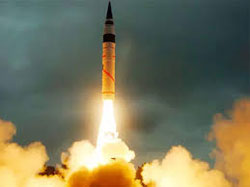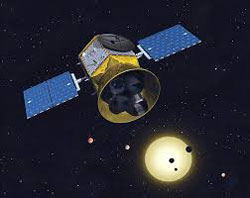January 2020 Science and Technology
Sakshi Education
- Vyom - India's first robot 'astronaut'
 India's space agency has unveiled a robot that will travel to space later this year as part of an unmanned mission.
India's space agency has unveiled a robot that will travel to space later this year as part of an unmanned mission.
Scientists hope that it will be able to later assist astronauts in a manned space mission called Gaganyaan, which is scheduled for December 2021.
ISRO will conduct two unmanned missions - one in December this year and another in June 2021 - before the Gaganyaan mission.
The robot, which has been named Vyom Mitra (which translates from the Sanskrit to friend in space) is designed to perform a number of functions including responding to astronaut's questions and performing life support operations.
- Bhuvan Panchayat V3 web Portal to enhance network application of gram panchayats
Union Minister of State for PMO Dr Jitendra Singh launched the Bhuvan Panchayat V3 web Portal that will enhance network application of gram panchayats. The Portal will function with the help of satellite technology developed by ISRO.
Indian space technology is designed to benefit every Indian household. The workshop on space-based information support for decentralized planning s will connect gram panchayats and help the flow of information.
ISRO applications contribute to national development through space program, keeping the socio-economic well being if citizens in focus. Secretary, Ministry of Panchayat Raj, Sunil Kumar and other senior officials were present on this occasion.
- Govt targets to install 175 Giga Watt renewable energy by 2022
The Government has targeted to install 175 Giga Watt renewable energy by 2022 to build a healthy plant with less carbon intensive economy.
Through Pradhan Mantri Kisan Urja Surkasha Evam Utthan Mahabhiyan, PM-KUSUM scheme, government empowers the farmers to be the producer of energy.
The PM-KUSUM scheme covers grid connected renewable energy power plants, stand alone solar powered agricultural pumps and solarization of existing grid connected agriculture pumps.
The components of the scheme are installation of 10 thousand Mega Watt of Decentralized Ground Mounted Grid Connected Renewable Power Plants by farmers of 500 Kilo Watt to 2 Mega Watt capacity, installation of 17.50 lakh stand alone Solar Powered Agriculture Pumps and solarization of 10 Lakh Grid-connected Solar Powered Agriculture Pumps.
The Scheme has substantial environmental impact in terms of savings of CO2 emissions and all three components of the Scheme combined together are likely to result in saving of about 27 million tonnes of CO2 emission per annum.
- India successfully test-fires K-4 ballistic missile
 India has successfully test-fired a 3,500 kilometre range nuclear capable missile that can be launched from a submarine.
India has successfully test-fired a 3,500 kilometre range nuclear capable missile that can be launched from a submarine.
The test of the K-4 ballistic missile was conducted off the Vizag coast in Andhra Pradesh on 19 January, 2020.
With this test, India has moved one more step towards the induction of this ballistic missile on the INS Arihant class of nuclear submarines.
The missile was developed by Defence Research and Development Organisation (DRDO).
The three-metre-tall missile carries a nuclear warhead of over one tonne with a circular error probability far lower than that of Chinese ballistic missiles.
Only the US, Russia and China have submarine-launched ballistic missiles of 3,500-kilometre range.
The submarine-launched ballistic missile is the most important part of the air, land and sea nuclear triad and is at the front of India’s second-strike capability.
- France is to train Indian flight surgeons for Gaganyaan mission
France is to train Indian flight surgeons to enable them to monitor the health of astronauts selected for the human space mission Gaganyaan.
The announcement was released on 21 January 2020. A memorandum of understanding (MoU) regarding this is expected to be signed during French space agency CNES President Jean-Yves Le Gall's visit to India in January.
Flight surgeon training:- The training will be given for two-week. It is a critical aspect of the Gaganyaan project that is aimed at sending three Indians to space by 2022.
- The flight surgeons are the Indian Air Force (IAF) doctors specializing in aviation medicines and responsible for the health of astronauts before, during and after the flight
- The surgeons will be shortlisted soon.
- Those selected surgeons will undergo two weeks of training in France.
India-France relationship:- India and France share strengthened ties in the area of space. The two countries had signed a joint vision for space cooperation in March 2018.
- The agreement came even before Prime Minister Narendra Modi announced the Gaganyaan project.
- Indian Navy signed MoU for offshore Data with GSI
Indian Navy signed a Memorandum of Understanding (MoU) with Geological Survey of India (GSI) on 21 January 2020.
The MoU was signed by Commodore AA Abhyankar, who heads the Indian Navy's Oceanology and Meteorology Directorate and Shri N Maran, Deputy Director-General of GSI.
MoU Highlights:- The MoU aims to ensure the sharing of seabed sediment data, products and expertise for Naval Application in Meteorology and Oceanography.
- GSI's Marine and Coastal survey Division based at Mangaluru has mapped most of India's 2.1 Million sq. km Exclusive Economic Zone and has a vast repository of offshore data.
- As per the MoU, the data collected using GSI's oceanic research vessels Samudra Manthan, Samudra Ratnakar, Samudra Kaustubh and Samudra Shaudhikama will be used by Indian Navy's blue water fleet. Reliable and accurate oceanographic modeling will support the fleet's expansive maritime operations in the Indian Ocean region.
- IAF inducts its first squadron of Sukhoi-30 MKI aircraft equipped with BrahMos missiles
The Indian Air Force has inducted its first squadron of Sukhoi-30 MKI aircraft carrying the BrahMos missiles in the South at its Thanjavur base in Tamil Nadu.
The Chief of Defence Staff General BipinRawat and the Chief of Air Staff, Air Chief Marshal Rakesh Kumar Bhadauria inducted the squadron at an impressive ceremony.
The newly reinstated 222-squadron, also known as the Tigersharks, would serve as a lethal weapons platform capable of carrying both aerial and maritime roles in the Indian Ocean Region.
Six of India’s 10 most polluted cities in UP, Jharkhand’s Jharia tops list Lunglei in Mizoram is the least polluted and only Indian city with PM levels under the World Health Organisation’s (WHO) prescribed level of 20/ug/m3 (micrograms per cubic meter), according to Greenpeace India.
Six of India’s 10 most polluted cities are in Uttar Pradesh, according to Greenpeace India’s fourth Airpocalypse report released.
Noida, Ghaziabad, Bareilly, Allahabad, Moradabad and Firozabad in Uttar Pradesh figure in list of 10 most polluted cities topped by Jharia in Jharkhand and closely followed by Dhanbad in the same state.
- New snake eel species discovered in Odisha
A new snake eel species residing in the Bay of Bengal has been discovered and documented this month (January) by the Estuarine Biology Regional Centre (EBRC) of the Zoological Survey of India (ZSI) at Gopalpur-on-sea in Odisha.
This new marine species has been named Ophichthus kailashchandrai to honour the vast contributions of Dr.Kailash Chandra, Director of ZSI, to Indian animal taxonomy.
- Indian Railways’ first waste to energy plant commissioned
First waste to energy plant of Indian Railways has been commissioned at Carriage Repair Workshop, Mancheswar, East Coast Railway (ECoR). It is fourth such plant in the country.
“This is the first government of India initiative in waste to energy plant of such large scale. Here world class technology has been inducted to deal with garbage disposal.
- Scientists set up India’s first solar-powered Biorock to conserve endangered corals
Marine scientists from the Zoological Survey of India (ZSI) have installed the country’s first solar-powered Biorock in the Gulf of Kutch off the Gujarat coast to regenerate endangered corals.
Biorocks are steel structures that installed on the seabed and are connected to a power source, such as solar panels, which stay afloat on the sea surface. Very low doses of electricity – less than 12 volts – are passed through the steel structure via cables.
- 17-year-old high school student discovers rare new planet 3 days into NASA internship
 NASA’s planet hunter satellite TESS has discovered an exoplanet orbiting two stars instead of one - and it was identified by a high school intern.
NASA’s planet hunter satellite TESS has discovered an exoplanet orbiting two stars instead of one - and it was identified by a high school intern.
But the newly found planet's size alone — it is 6.9 times larger than Earth, almost the size of Saturn — makes it unlikely to be livable.
Named TOI 1338 b, it is the only planet in the TOI 1338 system, which lies 1,300 light-years away in the constellation Pictor, and orbits its stars every 95 days.
The two stars orbit each other every 15 days. One is about 10 percent bigger than our Sun, while the other is cooler, dimmer and only one-third the Sun’s mass. TOI 1338 b was identified by Wolf Cukier.
- 7 billion years: Scientists say Earth’s oldest solid material found
Researchers said that new techniques have allowed them to identify the oldest solid material ever found on earth.
The stardust, formed five to seven billion years ago, came from a meteorite that fell to Earth 50 years ago in Australia.
It came down in 1969 in Murchison, Victoria state, and scientists from Chicago’s Field Museum have possessed a piece of it for five decades.
Philipp Heck, curator of meteorites at the museum, examined pre solar grains, which are bits of stardust that become trapped in meteorites, making them time capsules of the period before the sun was born.
- India’s first satellite of 2020 Gsat-30 successfully launched
In the first mission of the year for the Indian Space Research Organisation (ISRO), India’s forty-first communication satellite – GSAT 30 – was launched by the European commercial launcher Arianespace.
The satellite will enhance television broadcasting, satellite-based news gathering, and direct-home services.
India's communication satellite #GSAT30 was successfully launched into a Geosynchronous Transfer Orbit by #Ariane5 #VA251.
GSAT-30:
GSAT-30 weighs around 3,357kg
The communication satellite aims to serve as a replacement to INSAT-4A spacecraft services with enhanced coverage
The satellite is expected to provide coverage in Ku-band that covers Indian mainland and islands
It has extended coverage in C-band that covers Gulf countries, a large number of Asian countries and Australia.
The life span of the GSAT is 15 years
The communication payload of GSAT-30 is specifically designed and optimized to maximize the number of transponders on the spacecraft bus.
The satellite will be extensively used for supporting VSAT network, DTH television services, television uplinking and teleport services, cellular backhaul connectivity, digital satellite newsgathering (DSNG), and many other applications.
One Ku-band beacon downlink signal is transmitted for ground-tracking purposes.
- A new species of bone-eating worm has been discovered in the Gulf of Mexico
Scientists discovered a new species of bone-eating worm during a study to investigate the deep ocean's ecosystem.
The bone-eating worm is yet to be named. It is the first of its kind found in the Gulf of Mexico.
Discovery:
For the study, the scientists dropped alligator carcasses into the Gulf of Mexico. The species crawled on the corpse of an alligator on the ocean floor and completely consumed its soft tissue within 51 days.
The bone-eating worm belongs to the Osedax family, a genus of deep-sea bone worms.
The new species is native to the Gulf of Mexico.
It has also been discovered that the clade to which the new species belongs is widely distributed from California to Japan to Antarctica
Currently, there is no obvious biogeographic pattern to its discovery in the Gulf of Mexico.
- Rajnath Singh flagged off 51st K9 VAJRA-T Gun from Larsen and Turbo Armoured System Complex in Gujarat
Defence Minister Rajnath Singh flagged off 51st K9 VAJRA-T Gun from Larsen & Toubro (L&T) Armoured System Complex at Hazira, Gujarat on 16 January 2020.
The participation of the private sector in defence manufacturing is toward fulfilling the government's commitment to make India an arms manufacturing hub and net defence exporter.
51st K9 VAJRA-T Gun:
51st K9 VAJRA-T gun weighs 50 tonnes
It can fire 47kg bombs at 43 kilometre distant targets
It can also turn around at zero radius.
In 2017, L&T won the Rs.4,500 crore contract from the Ministry of Defence to supply 100 units of K9 Vajra-T 155 mm/52 calibre tracked self-propelled gun systems to the Indian Army.
The K9 Vajra contract involves the delivery of 100 such systems in 42 months. This is the largest contract awarded to a private company by the Ministry of Defence (MoD).
- Centre to help states to set up vehicle tracking system
Ministry of Road Transport and Highways has announced that it will provide support to state governments to help them set up monitoring centres that will track public service vehicles including buses and cab operators like Ola and Uber.
The move aims to ensure the safety of passengers using public transport in the country.
Transport vehicles monitoring centres:
Supreme Court-mandated all public transport vehicles to have vehicle tracking systems and emergency buttons with effect from 1 January 2020.
All the states have made small progress in setting up the monitoring centres.
Hence, the transport ministry is to provide financial support under the Nirbhaya Fund which is managed by the Ministry of Women & child development.
The estimated cost of the project is Rs.463 crore. Out of the total estimated amount, the Centre will bear Rs.332 crore, while the states will share Rs.131 crore.
Background:
Earlier, due to lack of funds, the State governments were not able to set up vehicle monitoring centres.
The Centre aims to provide a grant to states for effective implementation of the system. States like Kerala and Uttarakhand have established the centres but was not even able to know if public vehicles have these features since there is no body established to monitor these
- CSIR partners with DRDO to produce the Saras engine
The Council for Scientific and Industrial Research (CSIR) has partnered with the Defence Research and Development Organisation (DRDO) to produce the Saras engine.
Collaboration:
CSIR will take up the project jointly designing and developing an aero-engine which is a highly complex task.
All major systems of the Saras engine, except the power plants, are indigenous.
The prototype version of the Saras is being developed by the CSIR's National Aeronautical Laboratory (NAL).
The engine is powered by two Canadian Pratt and Whitney PT6A turboprop engines.
These are mounted on the rear of the fuselage instead of the wings and face rearwards.
A 14-passenger Saras plane which is currently undergoing flight trials will also have the capability to taxi in reverse. This special feature is not very common in aircraft.
Taxiing in reverse requires the jet blast from the engines to be directed forwards.
Before approving the design, the NAL will conduct 20 test flights of the Saras.
The engine will be produced by the state-owned Hindustan Aeronautics Limited (HAL).
- ISRO sets its fourth RAC-S in Karnataka
 ISRO has set up a regional academic centre for space (RAC-S) at the National Institute of Technology (NITK) at Surathkal in Karnataka's southwest Dakshina Kannada district.
ISRO has set up a regional academic centre for space (RAC-S) at the National Institute of Technology (NITK) at Surathkal in Karnataka's southwest Dakshina Kannada district.
ISRO will provide Rs 2 crore grant annually to NIT for the R&D projects and promotional activities through the year.
An agreement regarding this was signed between ISRO and NITK on 3 Jan 2020.
- Smallest galaxies with black holes found
Astronomers have discovered some smallest galaxies known to host massive black holes.
The study published in the Astrophysical Journal found 13 massive black holes, about 4,00,000 times as heavy as the Sun, in dwarf galaxies which are 100 times smaller than our Milky Way.
These galaxies are situated so far away that light from the Earth would take less than a billion years to reach them.
- ISRO proposes to set up Human Space Flight Centre in Challakere
The Indian Space Research Organisation (ISRO) has proposed a Rs.2,700 crore master plan to create a top infrastructure that will house its young Human Space Flight Centre (HSFC). The HSFC was formally announced in January 2019.
It currently works from a temporary place at the ISRO headquarters, Bengaluru, Karnataka.
ISRO has announced to set up India's world-class facility for training astronauts in three years at Challakere in Chitradurga district of Karnataka. The announcement was made by K. Sivan, ISRO Chairman and Secretary, Department of Space.
After establishing the centre, everything connected with events and planning of the Human Spaceflight Programme (HSP) will be moved to the Challakere campus.
It is expected that the 400-acre ISRO land at Challakere will be the single-stop consolidating infrastructure and activities related to space travellers.
India is currently paying a huge sum to Russia for the training of the first set of four astronaut candidates for the first Gaganyaan mission of 2022.
Also, HSP work is split across various centres like Vikram Sarabhai Space Centre in Thiruvananthapuram and the U.R. Rao Satellite Centre in Bengaluru.
- ISRO’s astronaut training hub in karnataka
The Indian Space Research Organisation (ISRO) has proposed Human Space Flight Centre (HSFC) at Challakere in Chitradurga district of Karnataka.
The facility is expected to become operational in 3 years.
ISRO aims to establish a self-contained training facility.
At present, astronauts part of Gaganyaan Mission, the Human Spaceflight Programme of ISRO are trained in Russia.
- ISRO to Launch IDRSS Satellites
ISRO has announced that it aims to launch its own satellite pair for space communication purposes, called Indian Data Relay Satellite System (IDRSS).
IDRSS will be pivotal in maintaining communication with the astronaut crew and ground mission control at any given phase, during manned space missions.
The two satellites, which will be deployed in phases, are already being worked on by ISRO.
- ISRO is planning to launch satellite Aditya to study Sun
 ISRO is planning to launch a satellite called Aditya to study the sun.
ISRO is planning to launch a satellite called Aditya to study the sun.
India is quite advanced in the field of astronomy and ISRO has taken path-breaking initiatives in this field.
That India has many powerful telescopes around the country including a giant meter-wave telescope near Pune and other powerful telescopes located in Kodaikkaanal, Udagamandala, Guru Shikhar and Hanle Ladakh.
The citizens should strive to understand India's ancient knowledge in astronomy and modern achievements in this field.
- Astronaut Christina Koch created a record
NASA Astronaut Christina Koch created a record for the longest single spaceflight by a woman, surpassing the earlier record of 288 days in space.
When she arrives back on Earth in February 2020, she will have spent more than 300 days in space.
She is onboard the International Space Station since 14th March 2019.
- India to launch Chandrayaan-3 this year – Dr. Jitendra Singh
India will launch Chandrayaan-3 in 2020 says union mininster Dr. Jitendra singh.
The mission cost will be less than Chandrayaan-2.
The experience gathered from Chandrayaan-2 and available infrastructure will bring down the cost of Chandrayaan-3.
Chandrayaan-2 mission was India's first attempt to land on lunar surface.
The Indian Space Research Organization had planned its landing on the South Pole of the lunar surface.
- ISRO launched many successful missions in 2019
Indian Space Research Organisation-ISRO has successfully accomplished 13 missions including 06 launch vehicle missions and satellite missions during the year 2019.
Besides, 50 foreign satellites from seven countries were launched on a commercial basis during this period.
PSLV-C44 successfully launched Microsat-R and Kalamsat-V2 in January this year from Sriharikota.
- Government to give 5G spectrum for trails to all telecom players- Ravi Shankar Prasad
The Indian government decided to allocate spectrum to all telecom operators and equipment makers for the upcoming 5G trials in the country.
The announcement made by India's federal technology and communications minister, Ravi Shankar Prasad. The government decided to give 5G Spectrum for a trial to all operators in the country.
The Chinese telecom equipment maker Huawei to conduct super-fast speed 5G network trials in India. Indian telecom industry.
5G is the fifth-generation wireless technology for digital cellular networks wide deployment in 2019.
The frequency spectrum of 5G is divided into millimeter waves, mid-band, and low-band.
- ISRO to set up second launch port in Thoothukodi district
Indian Space Research Organisation (ISRO) establish a second launch port in Thoothukodi district in Tamilnadu exclusively to launch small satellite launch vehicles.
ISRO Chairman K Sivan informed that this would come up in 2300 acres.
The line of GPS navigation system developed by America, the Indian navigation system called Navic with the indigenous atomic clock, will be operational with mobile phone manufacturers coming forward to install the regional navigation device.
Chandrayaan 3 mission to the moon comprising of a lander and a rover is approved by the Union Government.
India’s first human-crewed mission to outer space Gaganyaan and four men selected from Indian Air Force will leave for Russia in the third week of January to get training. The Gaganyaan mission targeted to launch by 2022.
The uncrewed missions will be launched to test the crew module with robots resembling humans.
This uncrewed space mission will test spacecraft re-entry technology, space capsule recovery experiment and the effect of microgravity on the crew module necessary for human space travel.
- Ring of Hydrogen Gas Discovered in Galaxy
A team of astronomers at the National Centre for Radio Astrophysics (NCRA) in Pune, India have discovered a mysterious ring of hydrogen gas around a distant galaxy.
Giant Metrewave Radio Telescope (GMRT) was used to discover it.
The ring is much bigger than the galaxy it surrounds and has a diameter of about 380,000 light-years (about 4 times that of our Milky Way).
Published date : 20 Jan 2020 05:31PM


















